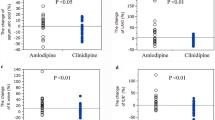Summary
A randomized, double-blind, placebo-controlled study was conducted to study the effects of acute and chronic administration of carvedilol in essential hypertension, with special emphasis on renal haemodynamics and function. Acute administration of a single dose of 50 mg carvedilol reduced systolic and diastolic blood pressure without inducing reflex tachycardia. Renal blood flow was preserved; accordingly, renal vascular resistance was significantly reduced. A significant reduction in the glomerular filtration rate and filtration fraction was observed. Plasma renin activity (PRA) and plasma aldosterone values were not changed. Chronic carvedilol treatment produced a significant fall in systolic and diastolic blood pressure, heart rate, PRA and plasma aldosterone. Renal blood flow, glomerular filtration rate and filtration fraction also remained unchanged; renal vascular resistance decreased significantly. It is concluded that carvedilol possesses definite antihypertensive and renal vasodilating properties, both acutely and after chronic treatment.
Similar content being viewed by others
References
Freis ED (1960) Hemodynamics in hypertension. Physiol Rev 40: 27–54
Zacest R, Reece PA (1984) Hydralazine. In: Doyle AD (ed) Clinical pharmacology of antihypertensive drugs. (Handbook of hypertension, vol 5) Elsevier, Amsterdam, pp 312–349
Zacest R (1976) The vasodilator-β-blocker interaction — some determinants of its clinical success. Aust N Z J Med 6 [Suppl 3]: 65–76
Hansson L (1983) Drug treatment of hypertension. In: Robertson JIS (ed) Clinical aspects of essential hypertension. Handbook of hypertension, vol 1 Elsevier, Amsterdam, pp 397–436
Eggertsen R, Hansson L (1985) Vasodilators in hypertension — a review with special emphasis on the combined use of vasodilators and β-adrenoceptor blockers. Int J Clin Pharmacol Ther Toxicol 23: 411–423
Gilmore E, Weil J, Chidsey C (1970) Treatment of essential hypertension with a new vasodilator in combination with β-adrenergic blockade. N Engl J Med 282: 522–527
Gottlieb TB, Katz FH, Chidsey CA (1972) Combined therapy with vasodilator drugs and β-adrenergic blockade in hypertension. Circulation 45: 571–582
Zacest R, Gilmore E, Koch-Weser J (1972) Treatment of essential hypertension with combined vasodilation and β-adrenergic blockade. N Engl J Med 286: 617–622
Hansson L, Zweiffler AJ (1973) Combined treatment of hypertension with vasodilatation and β-adrenergic blockade. Mich Med 72: 695–698
Abshagen U (1987) A new molecule with vasodilating and β-adrenoceptor blocking properties. J Cardiovasc Pharmacol 10 [Suppl 11]: S23-S32
Strein K, Sponer G, Müller-Beckmann G, Bartsch W (1987) Pharmacological profile of carvedilol, a compound with β-blocking and vasodilating properties. J Cardiovasc Pharmacol 10 [Suppl 11]: S33–841
Tomlinson B, Bompart F, Graham BR, Liu JB, Prichard BNC (1988) Vasodilating mechanism and response to physiological pressor stimuli of acute doses of carvedilol compared with labetalol, propranolol and hydralazine. Drugs 36 [Suppl 6]: 37–47
Gragnon JA, Mailloux LV, Doulittle JE, Teschan PE (1970) An isotopic method for instantaneous measurements of effective renal blood flow. Am J Physiol 218: 180–186
Blaufox MD (1989) Measurement of renal function with radioactive materials. In: Blaufox MD (ed) Evaluation of renal function and disease with radionuclides: the upper urinary tract. Karger, Basel, pp 12–27
Meyer-Sabellek WA, Schulte KL, Thiede HM, Gotzen R (1983) Acute hypotensive response to the new antihypertensive agent BM 14.190 in essential hypertensive patients. J Hypertens 1 [Suppl 2]: 351–352
Eggertsen R, Andren L, Sivertsson R, Hansson L (1984) Acute hemodynamic effects of carvedilol (BM 13190), a new combined β-adrenceptor blocker and precapillary vasodilating agent, in hypertensive patients. Eur J Clin Pharmacol 27: 19–22
Eggertsen R, Sivertsson R, Andren L, Hansson L (1984) Haemodynamic effect of carvedilol, a new β-adrenoceptor blocker and precapillary vasodilator in essential hypertension. J Hypertens 2: 529–534
Hansson L, Zweiffler AJ, Julius S, Hunyor SN (1974) Hemodynamic effect of acute and prolonged β-adrenergic blockade in essential hypertension. Acta Med Scand 196: 27–34
Prichard NC, Owens CWI (1980) β-Adrenoceptor blocking drugs. In: Doyle AE (ed) Clinical pharmacology of antihypertensive drugs. Elsevier, Amsterdam, pp 169–224
Weber MA, Drayer JIM (1980) Renal effects of β-adrenoceptor blockade. Kidney Int 18: 686–699
Epstein M, Oster JR (1982) β-Blockers and the kidney. Miner Electrolyte Metab 8: 237–254
Epstein M, Oster JR (1985) β-Blockers and renal function: a reappraisal. J Clin Hypertens 1: 65–99
Dupont AG, Van der Niepen P, Bossuyt AM, Jonckheer MH, Six RO (1985) Nadolol in essential hypertension: effect on ambulatory blood pressure, renal haemodynamics and cardiac function. Br J Clin Pharmacol 20: 93–99
Piepsz A, Ham HR, Dupont AG (1989) Renal blood flow in renal disease and hypertension. In: Blaufox MD (ed) Evaluation of renal function and disease with radionuclides: the upper urinary tract. Karger, Basel, pp 150–194
Rasmussen S, Nulsen PE (1981) Blood pressure, body fluid volumes, and glomerular filtration rate during treatment with labetalol in essential hypertension. Br J Clin Pharmacol 12: 349–353
Cruz F, O'Neill WM, Clifton G, Wallin JD (1981) Effects of labetalol and methyldopa on renal function. Clin Pharmacol Ther 30: 57–63
Ljungman S, Aurell M, Hartford M, Wickstrand J, Wilhemsen L, Berglund G (1980) Blood pressure and renal function. Acta Med Scand 108: 17–25
Hollenberg NK, Adams DF (1976) The renal circulation in hypertension disease. Am J Med 60: 773–784
De Leeuw PW, Schalekamp MADH, Birkenhäger WH (1983) The renal circulation in hypertension. In: Robertson JIS (ed) Clinical aspects of essential hypertension. (Handbook of hypertension, vol 1) Elsevier, Amsterdam, pp 202–204
Taylor EM, Roe AM, Slater RA (1979) SKF 92657, a novel antihypertensive acting by precapillary vasodilatation and β-adrenergic blockade. Clin Sci 57: 433S-436S
Bockringer K, Weidmann P, Link L, Bianhetti L, Schiffl H, Reubi FC (1983) Acute effects of combined vasodilation and β-adrenoceptor blockade with prizidilol on renal function. Br J Clin Pharmacol 15: 181–188
Author information
Authors and Affiliations
Rights and permissions
About this article
Cite this article
Dupont, A.G. Effects of carvedilol on renal function. Eur J Clin Pharmacol 38 (Suppl 2), S96–S100 (1990). https://doi.org/10.1007/BF01409473
Issue Date:
DOI: https://doi.org/10.1007/BF01409473




